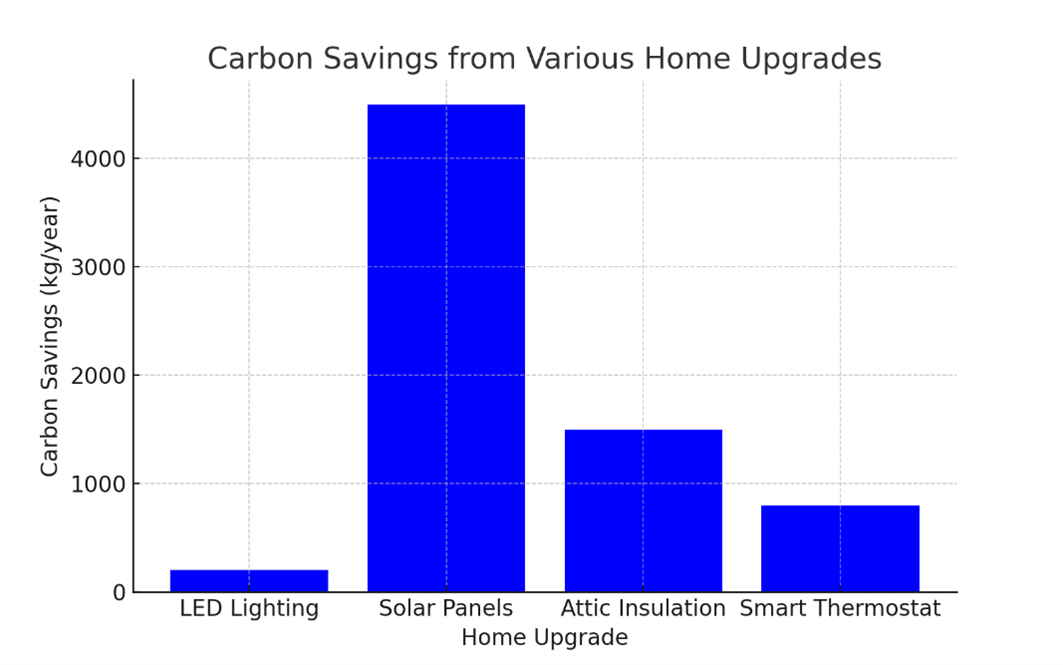Tips for Reducing Carbon Footprints at Home
Climate Resilience ?? Comments 08/Feb/2025 SatReducing your carbon footprint doesn’t require dramatic lifestyle changes; small, consistent steps can make a significant difference over time. Below are practical tips for minimizing emissions and promoting sustainability at home.
Details
-
Use Energy-Efficient Appliances
o Replace old appliances with ENERGY STAR-certified models, which consume less energy and perform more efficiently.
o Examples: ENERGY STAR refrigerators, dishwashers, and washing machines can reduce energy use by 10%-50% compared to older models.
o Benefit: Reduced energy consumption leads to lower electricity bills and decreased reliance on fossil fuels.
-
Switch to LED Lighting
o Replace incandescent and CFL bulbs with LED lights, which use 75% less energy and last up to 25 times longer.
o Impact: A family that replaces all incandescent bulbs in their home with LEDs can reduce their electricity usage for lighting by 20%-30%.
-
Adopt Renewable Energy
o Install solar panels or subscribe to a community solar program to power your home with clean energy.
o Use solar-powered outdoor lights and chargers for small devices as affordable alternatives.
-
Switch to Public Transportation or Carpooling
o Use public transportation, carpool, or bike to work to reduce emissions from single-occupancy vehicles.
o Impact: Reducing car usage by just one day per week can decrease a household’s annual carbon footprint by 1,000 pounds.
-
Minimize Water Waste
o Install low-flow faucets, showerheads, and toilets to conserve water.
o Fix leaks promptly; even a small leak can waste gallons of water daily.
o Use rain barrels to collect water for outdoor use, reducing the demand on municipal water supplies.
o Benefit: Reduced water consumption not only conserves resources but also lowers the energy required to treat and pump water.
-
Optimize Heating and Cooling Systems
o Use a programmable or smart thermostat to maintain efficient temperature settings.
o Seal windows and doors to prevent drafts and reduce energy waste.
o Replace air filters regularly to keep HVAC systems running efficiently.
o Tip: Set your thermostat to 68°F in winter and 78°F in summer to balance comfort and energy efficiency.
-
Reduce Waste Through Recycling and Composting
o Separate recyclables like paper, plastic, and glass to ensure they are properly processed.
o Compost food scraps and yard waste to reduce landfill contributions and create nutrient-rich soil for gardening.
o Avoid single-use plastics by using reusable bags, bottles, and containers.
-
Choose Sustainable Food Options
o Reduce meat consumption, especially beef and lamb, which have a high carbon footprint due to methane emissions and rource-intensive production.
o Buy locally sourced and seasonal produce to reduce the carbon emissions associated with transportation.
o Grow your own vegetables or herbs in a home garden to minimize reliance on store-bought food.
-
Reduce Phantom Energy Use
o Unplug electronics when not in use, or use smart power strips to eliminate standby power consumption.
o Impact: Phantom energy can account for up to 10% of a household’s electricity use. Eliminating it saves energy and reduces costs.
-
Adopt Sustainable Laundry Practices
o Wash clothes in cold water to save energy used for heating.
o Air-dry clothes whenever possible instead of using a dryer.
o Run full loads to maximize efficiency and reduce water and energy waste.
Practical Example
Replacing Incandescent Bulbs with LEDs
• A family decides to reduce their electricity usage by replacing all the incandescent light bulbs in their home with LED bulbs.
• Steps Taken:
-
The family identifies 20 incandescent bulbs and replaces them with energy-efficient LED bulbs.
-
They choose bulbs with a lifespan of 25,000 hours, ensuring they won’t need replacements for years.
• Results:
-
The LED bulbs use 75%-80% less energy than the incandescent bulbs, reducing the family’s electricity bills by 20%.
-
Over the course of a year, the family saves approximately $200 on lighting costs and prevents about 1,000 pounds of CO₂ emissions.
Key Benefits of Reducing Carbon Footprints at Home
-
Lower Energy Costs:
Energy-efficient practices reduce utility bills, providing immediate financial benefits.
-
Environmental Impact:
Reducing energy use and waste decreases greenhouse gas emissions, conserving resources for future generations.
-
Improved Home Comfort:
Practices like sealing drafts or optimizing heating and cooling enhance indoor comfort while saving energy.
-
Resilience to Climate Change:
Conserving water, reducing energy reliance, and minimizing waste help households adapt to and mitigate the effects of climate change.
-
Contribution to Global Goals:
Individual actions contribute to broader efforts to meet international sustainability and climate targets, such as those outlined in the Paris Agreement.
By adopting these practical tips, households can significantly reduce their carbon footprints, save money, and contribute to a healthier planet.
